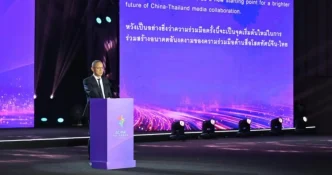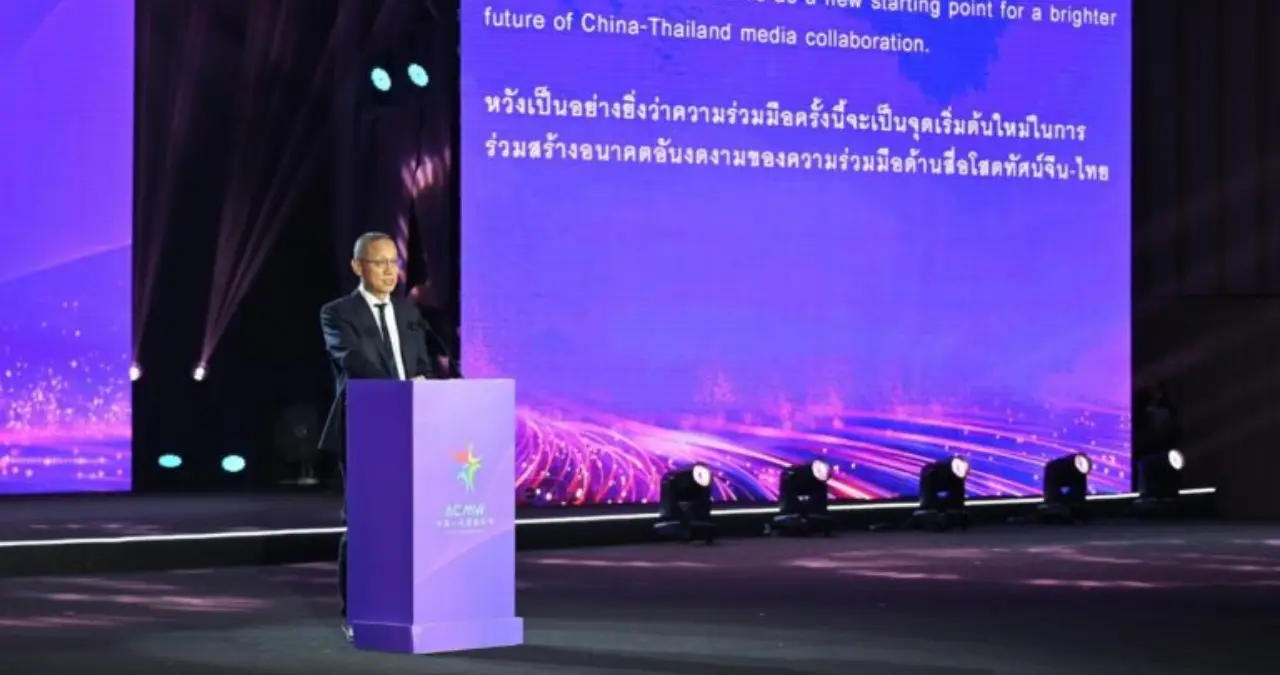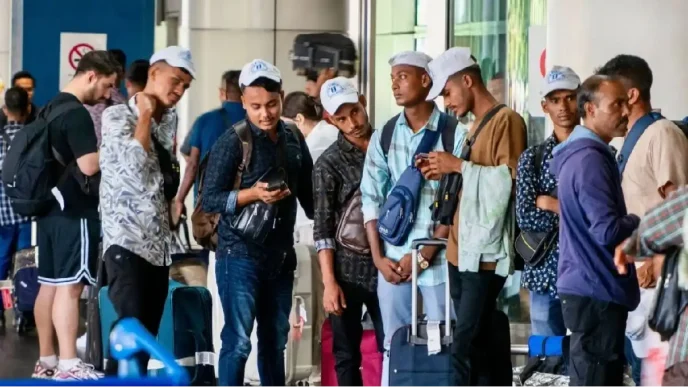Bangkok played host to the 7th ASEAN-China Media Week from June 26 to July 3, a significant event commemorating 50 years of diplomatic relations between Thailand and China. Under the theme “More Silk Road Cooperation, New Chapter Communication, Innovative Media Approach,” the initiative seeks to deepen media partnerships, enhance cultural exchange, and promote soft power across the region. With participation from media professionals, content creators, and government officials from ASEAN nations and China, the event underscores the growing importance of audiovisual media as a bridge for regional friendship and collaboration.
A Milestone in Diplomatic and Cultural Ties
The ASEAN-China Media Week, co-organized by China’s National Radio and Television Administration (NRTA), the Guangxi Zhuang Autonomous Region Government, Thailand’s Ministry of Culture, and the Thai Media Fund, opened with a grand ceremony at the Royal Thai Navy Convention Hall in Bangkok. Phonphum Wiphatphumiprathet, representing Thailand’s Prime Minister, presided over the event alongside senior officials and media representatives from across the region. The opening showcased a rich cultural program, featuring performances like Songs of the Silk Road, a China-ASEAN musical medley, and the visual spectacle Sea of Stars, alongside excerpts from the TV series Daughter of the Mountains and the documentary Li River.
In his address, Phonphum emphasized the event’s role as a vital platform for media and cultural cooperation. “This week brings together diverse voices to exchange ideas and build tangible partnerships across public, private, and people sectors” he said. He also reiterated Thailand’s dedication to leveraging international media collaboration to promote its soft power on the global stage, aligning with broader national goals to enhance cultural influence and economic ties.
Media as a Bridge for Regional Friendship
Dong Xin, Deputy Director of the NRTA, described the Media Week as a flagship initiative that strengthens ASEAN-China bonds through the power of audiovisual storytelling. “Media serves as a bridge connecting hearts and minds across our region” he said, expressing optimism that future collaborations would drive shared prosperity. He highlighted the deep ties between China and Thailand, likening their relationship to that of “one family,” a sentiment that resonates with the historical and cultural connections fostered over five decades of diplomacy.
Supporting this view, Suksit Srichomkwan, Thailand’s Deputy Secretary-General to the Prime Minister, stressed the media’s critical role in enhancing cross-cultural understanding and promoting sustainable peace. He outlined Thailand’s commitment to multidimensional partnerships, including joint content development, skills training, human resource exchanges, and the adoption of cutting-edge technologies to elevate media professionalism. The goal is to improve public well-being through informed, innovative media practices, underscoring the broader societal benefits of such initiatives.
Guangxi’s Strategic Role and Regional Impact
Hu Fan, Vice Chairman of the Guangxi Zhuang Autonomous Region, provided a regional perspective, noting Guangxi’s position as China’s gateway to ASEAN and its status as the bloc’s largest trading partner for 25 consecutive years. He cited impressive figures to illustrate the Media Week’s impact, including nearly 50 joint media projects, 678 broadcast programs across 450 platforms, and 30 co-produced audiovisual works. These achievements reflect the event’s success in fostering practical collaboration and amplifying cultural narratives across borders.
Hu also referenced Chinese President Xi Jinping’s recent visit to ASEAN, which yielded 105 bilateral agreements spanning artificial intelligence, connectivity, livelihoods, and media cooperation. These agreements signal a forward-looking approach to regional integration, with media playing a pivotal role in building mutual understanding and trust. If sustained, such efforts could further solidify ASEAN-China relations, potentially influencing economic and geopolitical dynamics in the Asia-Pacific region.
Innovative Programs and People-to-People Engagement
Thanakorn Srisuksai, Manager of the Thai Media Fund, detailed the week’s packed agenda, which includes the ASEAN-China Media Industry Cooperation Conference, the ASEAN-China Film Culture Week in Thailand, and the ASEAN-China Broadcast Dubbing Initiative. Operating under the theme “Two Nations, One Vision,” these programs aim to deepen people-to-people engagement and promote high-quality cooperation. The week long event creates spaces for shared stories and visions that resonate across cultures, highlighting the potential for media to unite diverse communities.
The focus on dubbing initiatives and film culture reflects a growing recognition of the power of localized content to reach wider audiences. By translating and adapting audiovisual works, ASEAN and Chinese media organizations can cater to linguistic and cultural nuances, making their productions more accessible and impactful. This approach not only boosts viewership but also fosters a sense of shared identity, a key objective of the Media Week.
Thailand’s Soft Power Ambitions
Thailand’s participation in the ASEAN-China Media Week aligns with its broader strategy to position itself as a regional hub for cultural and creative industries. The country has increasingly prioritized soft power as a tool for diplomacy and economic growth, leveraging its rich heritage, cuisine, and entertainment sectors to attract global interest. Events like this provide a platform to showcase Thai culture while building partnerships that can amplify its influence.
The collaboration with China, a major player in global media and technology, offers Thailand opportunities to learn from advanced production techniques and digital platforms. At the same time, Thai media professionals can contribute their unique perspectives, ensuring that joint projects reflect a balance of cultural identities. If successful, these efforts could enhance Thailand’s standing in the regional creative economy, potentially drawing investment and talent to cities like Bangkok and Chiang Mai.
Broader Implications for ASEAN-China Relations
The ASEAN-China Media Week is more than a celebration of bilateral ties; it represents a strategic effort to counterbalance geopolitical tensions in the region through cultural diplomacy. As China expands its influence in Southeast Asia via initiatives like the Belt and Road, media cooperation offers a less contentious avenue for engagement. By focusing on shared narratives and mutual benefits, events like this can help mitigate mistrust and build goodwill among nations with diverse political systems and historical grievances.
Moreover, the emphasis on innovation—seen in discussions around AI and technology adoption—positions media as a frontier for regional progress. Joint projects could lead to advancements in content delivery, such as streaming platforms tailored to ASEAN audiences, or the use of virtual reality to create immersive cultural experiences. While challenges like censorship and differing regulatory frameworks may arise, the commitment to dialogue during the Media Week suggests a willingness to address such issues collaboratively.
Looking Ahead: A New Chapter for Regional Media
As the 7th ASEAN-China Media Week draws to a close, its impact on regional cooperation is already evident in the partnerships forged and the stories shared. The event has laid the groundwork for future initiatives that could transform how media connects communities across ASEAN and China. With Thailand at the forefront of this cultural exchange, questions remain about how these efforts will evolve—will they lead to a truly integrated regional media landscape, or will national interests continue to shape the narrative?
For now, the vibrant performances and collaborative spirit of the week serve as a reminder of the power of media to transcend borders. As new projects take shape, they carry the promise of a deeper, more connected ASEAN-China relationship, one frame at a time.
















